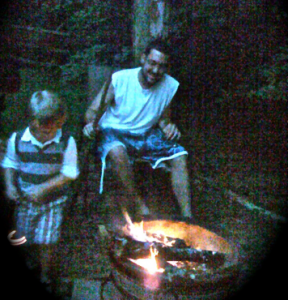Master’s student, Christopher Daniel Boone, finished writing and successfully defended his thesis work, (see abstract below). He was accepted into the Ph. D. program at U. Florida beginning in the Fall 2010. He will move to Gainesville, Fl in August.
Conformational change within full-length HIV-1 gp120 upon ligation with T-cell receptor CD4 and neutralizing antibody IgG1 b12
Abstract:
Viral membrane glycoprotein gp120 is the key surface coat protein involved in HIV-1 human cellular recognition and initiating viral entry into the host cell. This viral entry is initiated by binding of gp120 to the first ectodomain (D1) of the hosts four domain T-cell receptor CD4. After binding with CD4, the variable V3 loop of gp120 is extended out to ligate with a coreceptor on the T-cell surface, CXCR4 or CCR5. Small-angle X-ray scattering (SAXS)-derived structural perimeters and models of the unliganded soluble CD4 constructs (sCD4D1-D2, sCD4D1-D4) agreed well with previously reported crystallographic data with sCD4D1-D4 adapting a ‘Z’-conformation in solution. Likewise, SAXS data analyses of HIV-1SF162 gp120 ligated with both sCD4 constructs revealed a conformational change in the D2-D3 linker region within sCD4D1-D4 which rotates the D3/D4 subdomains with respect to D1/D2 subdomains, changing the overall shape of sCD4D1-D4 from a ‘Z’- to a ‘U’-configuration upon binding gp120. This conformational change of sCD4D1-D4 upon binding HIV-1 gp120 is believed to be the key event that brings the extended V3 loop of gp120 into close enough proximity with the T-cell coreceptor which then initiates viral entry into the host cell.
Neutralizing antibody IgG1 b12 has been shown to clear a wide array of HIV-1 strains by binding to gp120 at the CD4 epitope. The crystal structure of this antibody displays a highly asymmetric conformation with a shift of the Fc domain so that it lies directly underneath one of the Fab domains (FabC) while the other Fab domain is extended out (FabE). Our SAXS-derived models for unliganded IgG1 b12 revealed that this characteristic asymmetric shape is the predominate conformation in solution where the antibody is free of crystal packing forces. Upon mixing a 1:2 molar ratio of IgG1 b12 and HIV-1BaL gp120, SAXS analyses indicate that the most abundant scattering entity is the 1:1 antibody/antigen binary complex in solution and not the expected 1:2 Ab/Ag ternary structure.
Small-angle neutron scattering (SANS) of unliganded HIV-1SF162 gp120 and the gp120/sCD4D1-D2 binary complex was collected at various solvent D2O levels. This contrast series was carried out to reveal possible conformational changes of the extensive surface glycoslyation of HIV-1SF162 gp120 upon binding sCD4D1-D2. SANS-derived models and analysis of structural parameters revealed a possible candidate for the scattering density of the V1/V2 emanated loop of HIV-1SF162 gp120 known to coordinate ligation of CD4 as well as a possible shift in the surface glycosylation of gp120 upon binding sCD4D1-D2.
